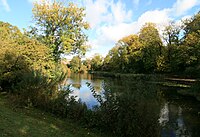Østre Anlæg
| Østre Anlæg | |
|---|---|

The lake
|
|
| Type | public park |
| Location | Copenhagen, Denmark |
| Area | 12 hectares |
| Created | 1870 |
| Operated by | Copenhagen Municipality |
| Status | Open all year |
Østre Anlæg is a public park in Copenhagen. Once it was a part of the old city fortifications. The park was designed by landscape architect H.A. Flindt who also designed Ørstedsparken and Copenhagen Botanical Garden on the old fortification. The park lies between The National Art Museum at the southern end, and Oslo Plads and Østerport Station at the northern end. There are three lakes in this park, they used to be part of the moat system.
Østre Anlæg is located on land where Copenhagen's former ring fortification ran until the second half of the 19th century. At the initiative of Ferdinand Meldahl, it was decided to reserve much of the land for new public parkland. Østre Anlæg was created when the landscape architect Ole Høeg Hansen converted a section of the old Rast Rampart into an English-style landscape park in the 1870s. His initial plan was created in 1872 but progress on its implementation was slow and the northwestern margin of the park remained loosely defined.
The new National Gallery opened in a corner of the park in 1896. The building was designed by Vilhelm Dahlerup. A few years later, the tobacco manufacturer Heinrich Hirschsprung offered to donate his art collection to the Danish state on condition that the state and City of Copenhagen would make a building available for its exhibition at a site close to the National Gallery. A small piece of the park located next to was made available to the project and the Hirschsprung Collection's building opened in 1911.
The Denmark Monumentm created in connection with Christian IX and Queen Louise's gold wedding, was originally located in front of the National Gallery. The monument, which was designed by Louis Hasselriism was poorly received by the public as well as critics. In 1919, it was decided to move it to its current location in Østre Anlæg.
...
Wikipedia
